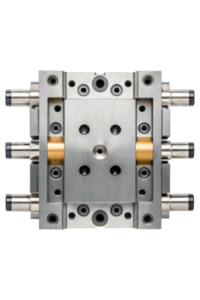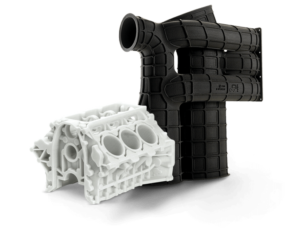SLS vs. MJF – which is better for tough, end-use parts?
When manufacturing durable, functional end-use parts, selecting the right 3D printing technology can make a huge difference in performance, efficiency, and cost. Two of the most widely used methods today are Selective Laser Sintering (SLS) and Multi Jet Fusion (MJF). While both rely on powdered nylon materials and produce high-strength components, each technology offers distinct advantages depending on your project’s priorities—whether that’s precision, durability, finish, or scalability.
In this blog, we’ll explore the key differences between SLS and MJF, highlight their ideal use cases, and help you determine which is best suited for your next product development phase.
Mechanical Strength & Performance: Both Deliver Reliable Results
Both SLS and MJF commonly use nylon PA12, a material known for excellent mechanical strength, chemical resistance, and thermal stability. Each can achieve tensile strength above 48 MPa and elongation at break between 10–20%, making them ideal for high-performance parts such as enclosures, housings, brackets, and more.
However, MJF tends to deliver slightly more isotropic properties, meaning it maintains consistent strength in all directions. This can be particularly beneficial in complex, load-bearing parts like robotic joints or moving assemblies. On the other hand, SLS is often preferred for parts that need to withstand high thermal or mechanical stress, especially in low- to mid-volume production runs where design freedom and proven durability are key.
Surface Finish & Aesthetic Details: Depends on Application Needs
In terms of surface finish, MJF generally produces smoother parts right out of the machine. Thanks to its fusing and detailing agents, MJF can create cleaner edges and crisper details with minimal post-processing, perfect for consumer-facing products such as wearable tech, automotive interiors, or appliance covers. It’s worth noting that MJF parts are predominantly gray to black in color due to the fusing process, which may be a limitation for applications requiring a broader color range or lighter aesthetics.
SLS parts may appear slightly grainier, but this surface texture is often acceptable or even preferred in industrial and technical applications. With simple finishing processes like media tumbling, dyeing, or coating, SLS parts can still achieve an impressive look and feel, especially when color flexibility or surface customization is important..
Production Speed & Efficiency: MJF Is Faster, SLS Offers Flexibility
MJF is typically faster than SLS when it comes to printing layers, as it fuses entire sections in a single pass, rather than tracing each layer point-by-point like SLS. This makes MJF a solid choice for high-volume, fast-turnaround jobs—think hundreds of helmet inserts, packaging fixtures, or consumer product enclosures.
That said, SLS offers more design freedom and part complexity, making it a go-to technology for functional prototyping or small-batch production of intricate geometries. The point-by-point laser sintering used in SLS allows for high precision, especially with parts that feature internal cavities or interlocking mechanisms.
Material Reusability: SLS Has a Slight Advantage (for Now)
When it comes to powder reusability, SLS generally allows 50–70% reuse, depending on the design and material blend. MJF follows closely, with many systems achieving up to 80% reuse. However, SLS has long been favored by manufacturers looking to optimize material costs and reduce waste, particularly in sustainability-focused workflows.
Modern MJF systems, like the HP Jet Fusion 5200 series, are quickly narrowing this gap with enhanced thermal control and powder management, making it easier to reuse more powder without compromising part quality.
Cost-Effectiveness: Depends on Volume and Complexity
Both SLS and MJF offer significant cost savings over traditional manufacturing methods, especially for short- and mid-run productions.
- MJF is often more cost-effective for larger production volumes (typically 100+ units) due to its faster print speeds, less post-processing, and higher packing efficiency.
- SLS shines in lower-volume, high-complexity jobs where intricate detail, strength, or proven performance in demanding environments is a must.
The best choice depends on your part geometry, finish requirements, and batch size.
Real-World Application: Steyr Arms x Quickparts
One compelling example of how SLS can support product success comes from Steyr Arms, a leading European firearms manufacturer.
To maintain strong brand recall among dealers and customers, Steyr wanted to create highly detailed, durable scale models of its rifles for use in showrooms and promotional events. Working with Quickparts, the team selected Selective Laser Sintering (SLS) as the preferred 3D printing method due to its design flexibility and ability to reproduce complex features with high durability.
“The ability to print very fine details and mechanical features helped us create replicas that are visually accurate and functionally impressive,” said the Steyr team.
These SLS-produced models not only captured attention but also streamlined production, allowing for cost-effective short runs without sacrificing design integrity.
Read the full case study here: Steyr Stays Top of Mind with Scale Models from Quickparts
Application Fit: Industry Examples That Tell the Story
Here’s how each technology plays out in the field:
- Automotive: MJF is being adopted by electric vehicle manufacturers for components like brackets and cable guides. Its smooth finish and quick turnaround are ideal for high-speed iterations.
- Healthcare: SLS is trusted for biocompatible nylon surgical guides and tools. Its ability to handle fine detail with high strength makes it ideal for patient-specific applications.
- Consumer Goods: Companies transitioning from SLS to MJF for products like fitness wearables report faster finishing and improved aesthetics, raising customer satisfaction.
- Robotics: Startups in automation often use MJF for quick deployment of functional end-use parts but turn to SLS for more intricate or mission-critical components with internal channels or pressure zones.
So, Which One Should You Choose?
If you’re building a highly complex part that needs to withstand demanding environments and design flexibility is your priority, SLS offers proven reliability and freedom.
If you need consistent strength across axes, faster build times, and a finished aesthetic with minimal post-processing, MJF can help accelerate your go to market timeline, especially for higher volumes.
At the end of the day, both SLS and MJF are valuable tools in modern manufacturing, and choosing the right one often comes down to the application, production volume, and performance expectations.
Let’s Build What’s Next, Together
At Quickparts, we don’t just offer the technology—we help you choose the right one for your unique challenge. With comprehensive additive manufacturing capabilities under one roof, our team is here to guide you from concept to component, every step of the way.
Quickparts can be your one-stop solution for advanced 3D printing technologies like Selective Laser Sintering (SLS), Stereolithography (SLA), Digital Light Processing (DLP), and more. Our experienced team will help you identify the right solution based on your application needs.
Get in touch today to find the best-fit solution for your next breakthrough.


